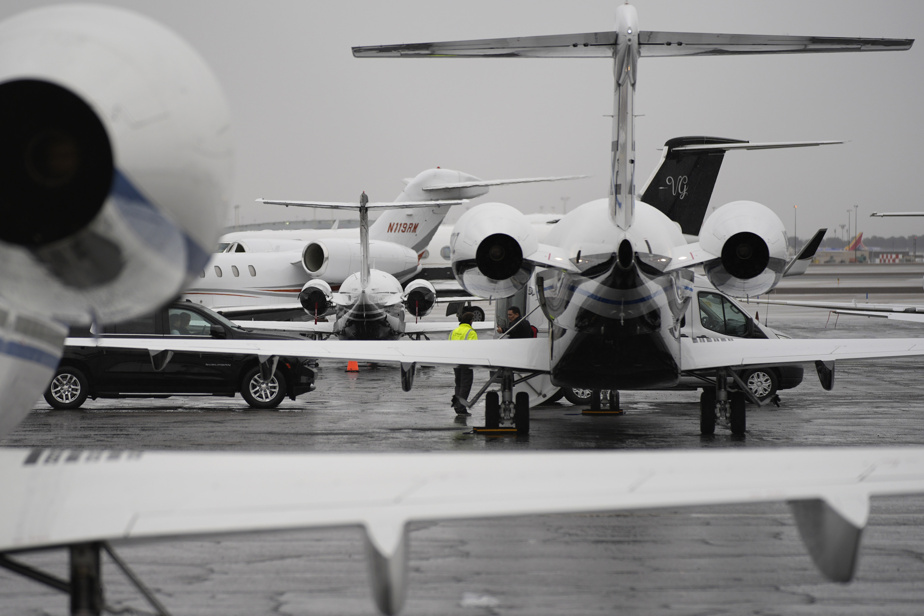Formula 1 is doing things in a big way. At the Canadian Grand Prix, racing cars exceed 300 km/h. The Montreal track is equivalent to a most intense 305 km competition over 70 laps. The crowd has already included Rihanna, Al Pacino, Penelope Cruz and Tom Brady. Last year, a record number of 345,000 spectators gathered at the Gilles Villeneuve circuit.
But perhaps the biggest – and most expensive – feature of this weekend is the fact that private jets ferry many of the thrill-seeking visitors.
About 115 business jets will land in the Montreal area between Friday and Sunday, which represents a 50% increase compared to the daily average of the previous month, according to projections provided to The Canadian Press by the analysis firm WingX.
Last year, 139 business jets arrived from the United States, Canada and as far away as Italy during the event weekend, an increase of 43% compared to 2019 and in line with the growing demand for private air travel since the COVID-19 pandemic.
Carbon dioxide emissions are also expected to increase, due to the race itself, but especially the aerial activity surrounding it.
“Private jets obviously have an outsized impact, because a private jet carries very few people on board, and very inefficiently,” said Thomas Green, climate policy advisor at the David Suzuki Foundation.
“And it can be even worse if the private jet goes to the event with some people and then returns empty to pick up other passengers, if it is chartered. »
In fact, about twenty business jets made several landings in Montreal during last year’s Grand Prix weekend. After landing, some probably took off without passengers in order to bring other people over the following days.
It can be difficult to put a precise figure on the carbon dioxide emissions of a group of private jets. But in general, these expensive planes are 5 to 14 times more polluting than commercial planes per passenger, according to the advocacy group Transportation
“When we look at global emissions from aviation passengers, just 1% of people are responsible for 50% of emissions,” said Thomas Green.
“There are a lot of super-rich and a lot of the business class who take a lot of business class flights or, for some of them, private jets. And their numbers are growing quite rapidly. »
This class includes the champagne-soaked world of F1, where big-money sport mixes with European aristocracy in a spectacle rich with competition, seduction and ego.
Although seven-time champion Lewis Hamilton sold his cherry red Challenger – made by Bombardier – for environmental reasons, current champion Max Verstappen travels the world in a private Dassault Falcon purchased from billionaire entrepreneur Richard Branson. Some teams, including Scuderia Ferrari, have partnered with companies such as VistaJet for private flights.
Barry Prentice, who heads the University of Manitoba’s transportation institute, says the role of private planes in promoting business relationships, economic activity and tourism should be taken into account when calculating their impact overall.
Formula 1 marks the unofficial kickoff of Montreal’s summer festival season, as pedestrians admire luxury cars and explore F1-themed kiosks on downtown’s Crescent Street before the Maxim Grand Prix party on Saturday evening.
“It has become the Montreal red carpet experience,” says Jean-Paul Mouradian, vice-president of Feldman Entertainment Quebec, which is promoting the unofficial F1 event, organized in a former Canadian Pacific train station. .
Tickets range from $260 to $20,000, with guests this year including tennis pro Eugenie Bouchard, American social media sensation Sommer Ray and Moroccan-American rapper French Montana.
“We learned from the airports –– Saint-Hubert, Montreal, Mirabel – that many private jets were landing,” Mr. Mouradian said, referring to the three main airports surrounding the city.
“It’s Netflix’s ‘Drive to Survive,’” he explains. It made things so frantic. »
F1 teams, crews and other personnel, some of whom arrived on board business jets, will number nearly 3,000 this weekend, according to the Canadian Grand Prix.
“The Netflix team is actually quite small. It usually has less than five people,” said Sandrine Garneau, brand strategy manager.
Amid all the excitement around elite motorsport, Thomas Green argues that any approach to business jets must be based on stricter regulation.
“It’s great when someone shows leadership and changes their lifestyle to reduce emissions, but we can’t count on that,” the environmentalist said, referring to Lewis Hamilton’s sale of private jets and pop star Taylor Swift’s purchases of carbon offsets.
“We need policies that help reduce emissions across the economy,” he insisted. These small planes don’t pay proportionately and they have an outsized impact on emissions. »




